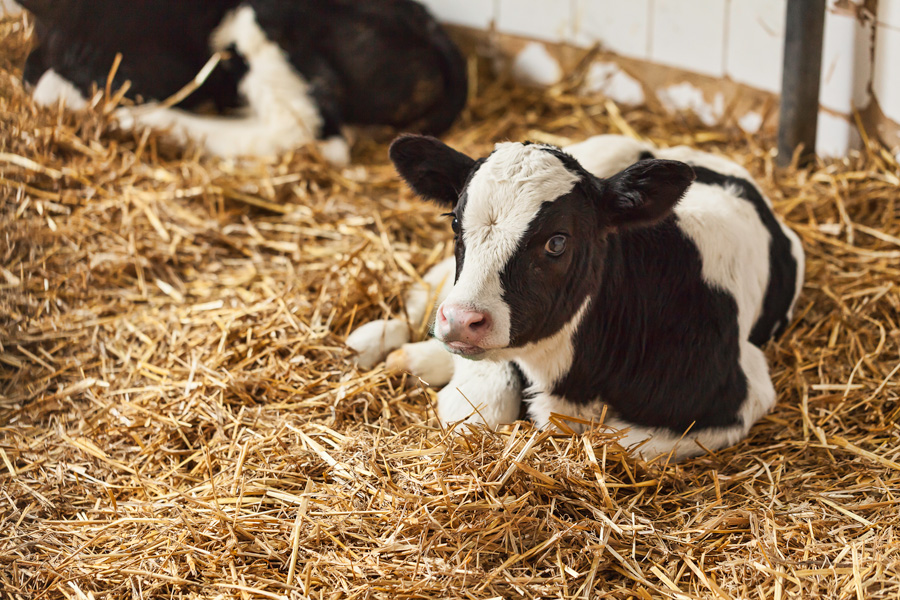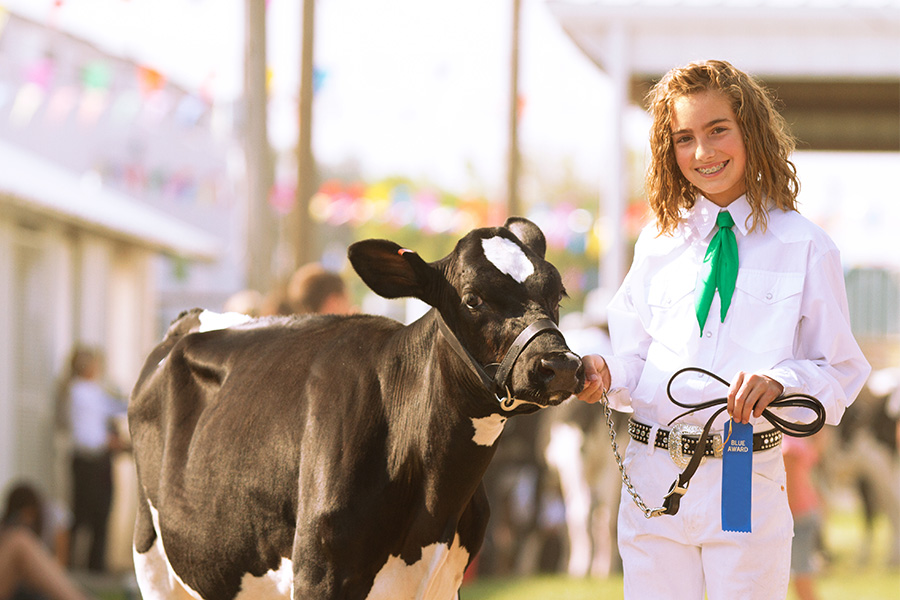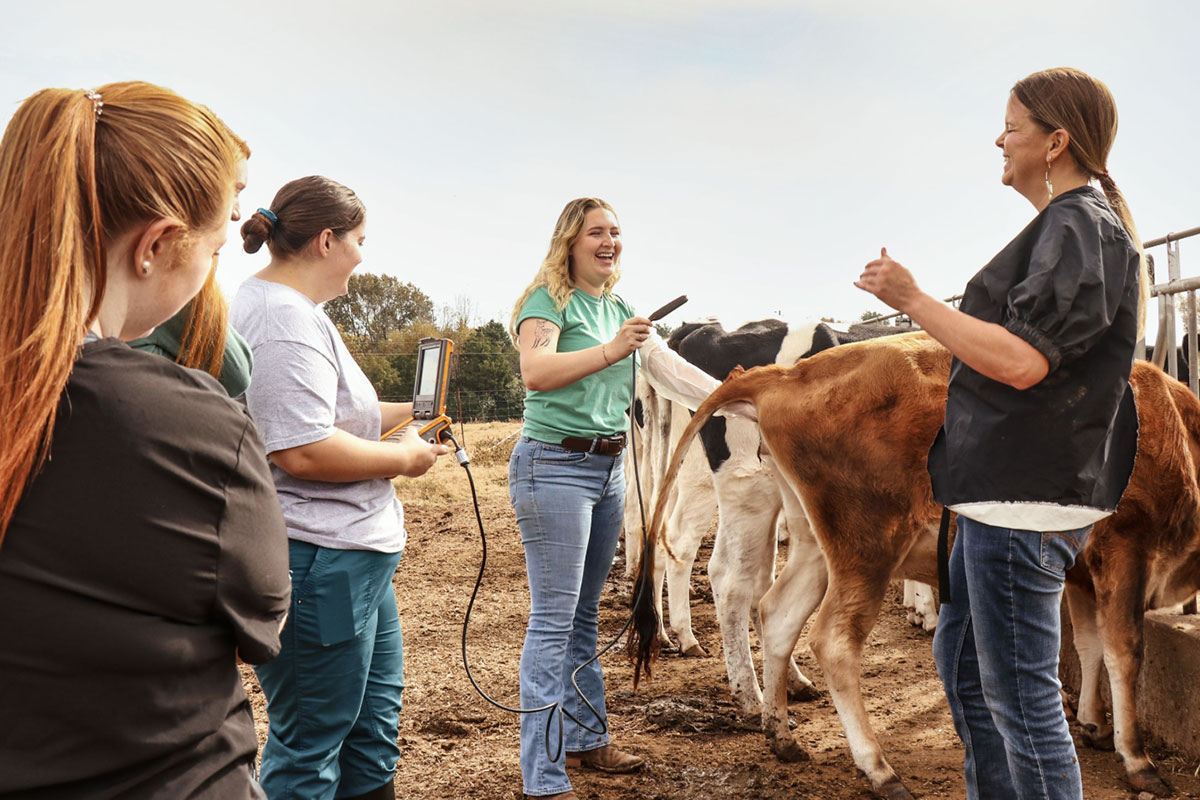
Some time ago, I was able to have several years of Spanish in high school and college. I was also required to take a written foreign language for my Ph.D. at the University of Kentucky. I remember a student in my class who was Chinese. I was amazed by his ability to go from Spanish to English to Chinese and back to English with every sentence. I was having enough trouble with two languages, and he was dealing with three. So now, especially in public places like Wal-Mart, I find myself overhearing others speaking Spanish. I am amazed at how much I don’t know. My daughter, who is a senior in high school, is actually much better than me at this, so often I find myself asking her for help. I have even noticed now when I visit dairies that more and more of our producers are speaking Spanish to better manage their labor force. When I try to communicate in Spanish, I often run out of words quickly.
The language
Spanish is really a neat language. It only takes three words to say “Do you speak Spanish?” (“¿Habla usted Español?”) verses four in English. Besides being spoken in Spain, Spanish is the official language of all the South American republics except Brazil and French Guyana, the six republics of Central America, as well as of Mexico, Cuba, the Dominican Republic and Puerto Rico. There are about 400 million people who speak Spanish worldwide. Pronunciation and usage of the spoken Spanish language naturally vary among countries, but regional differences are not so great. The Spanish language utilizes the Latin alphabet with a few special letters, including vowels with acute accents (á, é, í, ó, ú), dieresis u (ü) and n with a tilde (ñ). Letter combinations “ch” and “ll” are treated as single translation letters. For example, “ll” is pronounced “Y.” Both inflection and grammatical gender are important features of Spanish. The letter “O” at the end of a word is male and “A” is female in most cases. Like English, an “s” is added for plurals. Exclamatory and interrogative sentences are preceded by inverted question and exclamation marks such as “¿Habla usted Español?” Both second person “tú” and third person “usted” are used for “you.” “Ser” and “estar” are two verbs that both denote the translation of “to be.” “Ser” is used for essential characteristics and “estar” is used to describe what or how.
Adjectives are placed before nouns in Spanish. For example, “How now brown cow?” is actually “¿Ahora cómo vaca castaño?” (Now how cow brown?). “Got Milk” is also worth mentioning. There is no direct Spanish translation for “got.” The verb “tener” means “to have,” so “tiene leche” means “you have milk.” Other phrases like “nickel and dime” are actually translated “five and ten” (“cinco y diez”). Finally, some words don’t change; cervix is cervix.
One Way or the Other
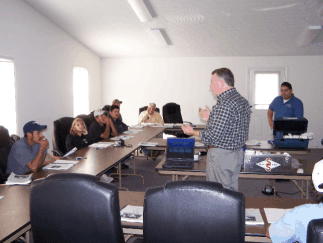 Reproductive Training Workshop in English and Spanish
Reproductive Training Workshop in English and SpanishIt seems to me that from a dairy standpoint, we have gone one way or another. For example, many publications have an English version and a Spanish version. Many of the wonderful articles many of us have enjoyed over the years have been translated for the Spanish version of Hoards Dairyman. Most of the time, publications don’t show two languages simultaneously, so it makes it harder to compare and to learn new terms and phrases. Several years ago, with the support of Pfizer Animal Health, UGA Extension sponsored an English/Spanish Reproductive Management Workshop. A training manual and PowerPoint presentations were developed in both languages. The setting was informal and allowed for plenty of interaction. Although slow at times, the day was a success. By the time we got to the hands-on afternoon section, everyone was helping each other and learning from each other. The main point is, when we were teaching our Spanish-speaking audience reproduction, we were also exposing our English-speaking audience to Spanish.
Getting Started
Like anything, the first steps are to start learning some vocabulary. Vocabulary knowledge relates directly to comprehension. These terms will help you better communicate at your dairy. You may want to cut out the common dairy terms at the end of this publication and put this list in your shirt pocket for reference.
Are you asking the right reproduction (reproducción) questions?
Students at UGA from South America helped me translate some of the following information to help producers better use Spanish to evaluate reproductive management and communicate with employees.Many times checklists are very handy to review management. After all, our goal for maximum lifetime leche (milk) is to get every vaca (cow) preñada (pregnant).
Tips for Better Semen Tank Management
How many of the following do you do? Answer Sí (Yes) or No (No):
- El tanque se encuentra siempre en un area donde puede facilmente ser visto (I keep my tank in an area where it can be easily observed)?
- Reviso el tanque a diario en busca de hielo alrededor de él, lo cual indica pérdida de vacío (I check the tank daily for external frost buildup, indicating a loss of vacuum)?
- Mantego mi tanque sobre una plataforma de madera y no sobre el concreto (I keep my tank on a wooden platform instead of on concrete)?
- Mantego el semen fuera del alcance de ácidos, abono, fertilizante y pesticidas (I keep my semen tank cleaning acids, manure, fertilizer and pesticides).
- Mi tanque está a mi alcance (Or al alcance de la mano) con el fin de poder reemplazar el nitrógeno líquido (My tank is easy to get to, so the nitrogen can be replaced).
- Muy rara vez transporto mi tanque de semen (I rarely transport my semen tank).
- Si alguna vez llevo el tanque a otro lugar, lo amarro en el camion para que vaya seguro (If I take the tank anywhere, I fasten it securely in the truck).
- Mantengo mi tanque lejos de cualquier contacto directo con los rayos de sol (I keep my tank out of direct sunlight).
- Mantengo a los niños y a los animals lejos del tanque (I keep children and animals away from the semen tank).
- Mantengo al semen protegido de vándalos y ladrones (I keep the semen protected from vandals and thieves).
- Mantengo mi tanque en un area donde haya luz, para así poder ver facilmente el cuello, con el fin de saber si necesito remover alguna pipeta o para el inventario (I keep my tank in an area where lighting is available so I can easily see into the neck for straw removal and inventory).
- Mido el nitrógeno líquido todos los días y vuelvo a abastecer cuando los niveles caen ente 3 pulgadas. Una pulgada es una bandera roja (I measure the liquid nitrogen monthly and replenish when level falls to 3 inches. One inch is a red flag).
- Siempre mantengo al mismo toro en una caña y el inventario de la ubicación del semen para poder encontrar fácilmente el semen que quiero sin tener que alzar una pipeta sobre la marca de las 5 pulgadas (I always keep the same bull on one cane and inventory of semen location so I can easily find the semen I want without raising a straw over the 5 inch mark).
- Llevo la cuenta de cuál toro tengo, de dónde se encuentran en el tanque (I keep accurate records of the bulls I have and where they are in the tank).
- El tanque se encuentra siempre en un area donde puede facilmente ser visto (I keep my tank in an area where it can be easily observed).
The first step to being pregnant or preñada…
Heat detection and ovulation synchronization are the essential first steps to getting an animal bred successfully. Either way, you gotta’ get ‘em bred (or preñada)!
Detection of heat (detectando el celo)…
Evaluate your heat detection program.
- ¿Veces al día (How many times a day do you look for heat activity)?
- ¿Minutos cada vez (How many minutes do you look each time)?
- ¿Rutina y Precision? (Your heat detection program must be routine and accurate, checked every day by someone who knows what they are doing.)
- ¿Superficie? (What kind of surface are they on when you watch? Cows on dirt are much more active.)
- ¿Relocalización? (Sometimes moving animals around will increase activity.)
- ¿Qué hacen los animales? (What are the animals doing? Eating and milking are the worst times to watch for heat.)
- ¿En cuanto tiempo está usted dispuesto a cruzarla otra vez (At what time are you willing to breed a cow back after she has calved)?
- ¿Reporta usted los celos en su información DHIA (Do you report heats on your DHIA information)?
Synchronization programs (programas de sincronización) will help…
Do you use any hormones on a routine basis? ¿Utiliza usted alguna hormona rutinariamente? Heats can be synchronized very efficiently and economically using a weekly prostaglandin (PGF) program (or programa semanal de PGF).
| Día 1 Inyectar PGF (Lunes a.m.) |
Day 1 Inject PGF (Monday a.m.) |
| Día 2-5 Detección de celo y AI (De martes a viernes) |
Day 2-5 Detect heat and AI (Tuesday to Friday) |
| Día 8 Reinyectar PGF las que no monta or las que no queden preñadas (Segundo lunes a.m.) |
Day 8 Reinject PGF those not bred (Second Monday a.m.) |
| Día 9-12 Detección de celo e inseminación |
Day 9-12 Detect heat and AI |
If you do not want to heat detect, you can synchronize ovulation and use timed AI.
- Inyectar PGF tras en Día 40 (Inject PGF after Day 40).
- Inyectar PGF 14 días siguiente después (Give the second PGF 14 days later).
- Inyectar GnRH 12 días siguiente después, normalmente el lunes (Then, 12 days later [generally on a Monday] give GnRH).
- El próximo lunes, inyectar PGF siete días siguiente después (Next Monday, or seven days later, give PGF).
- Inyectar GnRH dos días siguiente después, el miércoles (Then two days later [Wednesday] administer second GnRH).
- Inseminar todos los animales 16-24 horas después, el jueves (Finally, 16-24 hours later [on Thursday], artificially inseminate all animals).
With this protocol, 100 percent of your open cows will be inseminated in a very short period of time.
Insemination Techniques (Técnicas de Inseminación)
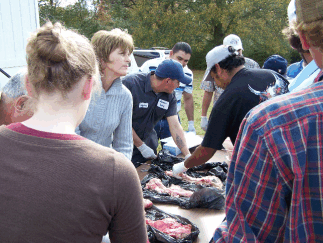 Hands-on AI training at workshop
Hands-on AI training at workshopFertility (fertilidad) is a challenge in dairy management. Unlike heat detection and post-partum breeding policies, drastic increases and improvements are much more difficult. When evaluating fertility, consider the following:
- Colocación del semen (semen placement).
- Manejo del semen (semen handling).
- Tiempo de crianza (time of breeding).
- Fertilidad del semen (semen fertility).
Using the following insemination techniques checklist (lista de técnicas de inseminación), review proper AI procedures with your employees.
- Use un guante nuevo para cada inseminación (Use a new glove for every insemination).
- Lubrica el guante con aceite mineral (Lubricate the glove with mineral oil or a commercial A.I. lubricant).
- Hable y toque el animal para avisarle que usted está presente (Speak to and touch the animal to make her aware of your presence).
- Masajee el ano con aceite mineral o lubricante (Massage the anus with mineral oil or lubricant).
- Cuidadosamente entre al recto formando un cono con sus dedos (Gently enter the rectum by forming a cone with your fingers).
- Cuidadosamente elimine completamente el estiércol del recto (Gently and thoroughly clean the rectum of manure).
- Revise el útero en busca de cualquier condición anormal (Check the uterus for any abnormal condition).
- Con una toalla de papel limpie el excuemento de la vulva y de su antebrazo (Clean manure from the vulva and from the underside of your arm with a paper towel).
- Abra la vulva empujando hacia abajo con su brazo sobre el recto (Spread the vulva by pushing down with your arm above the rectum).
- Con cuidado pase la pipeta a través de la vagina hasta la boca del canal cervical (Gently and smoothly pass the gun through the vagina to the opening to the cervical canal).
- Coloque la punta de la pipeta dentro del canal cervical (Place the tip of the gun into the os).
- Sostenga el cervix delante de la punta de la pipeta y manipule la cervix para permitir que la pipeta pase (Hold the cervix ahead of the gun’s tip and manipulate the cervix to allow the gun’s tip to pass).
- Evite pasar la pipeta a través del cervix si sospecha que puede haber gestación. Ojo: un tapón de moco pegajoso indica gestación (Avoid passing the gun through the cervix if pregnancy is suspected. Note: Pregnancy is indicated by a sticky mucus plug).
- Coloque su dedo índice al final de la boca del canal cérvical (Place your index finger at the far end of the cervical canal opening).
- Con cuidado mueva la punta de la pipeta hacia adelante hasta que la sienta con su dedo (Gently move the gun tip forward until you feel it with your finger).
- Introduzca la punta de la pipeta 0.25 pulgadas más alla después del final del cervix. El objetivo es del tamaño de un “centano” (Pass the gun tip one-quarter-inch past the end of the cervix. Your target is only the size of a dime).
- Asegúrese de que la punta de la pipeta no se encuentre atrapada en un área delgada entre los anillos cervicales (Be certain the gun tip is not caught in between cervical rings).
- Concéntrese en depositar el semen correctamente (Concentrate on accurate semen placement during deposition).
- Empuje el émbolo dentro de la pipeta lentamente por 5 seg (Slowly for 5 seconds, push the plunger into the straw gun).
- Si el animal se mueve, pare la deposición, una vez se detenga revise la posición y continue depositando (If the animal moves, stop the deposit. Wait until movement stops, check positioning, then continue to deposit).
- Con cuidado, saque la pipeta y revise por descargas anormal y por un depósito de semen completo (Gently remove the gun and check for an abnormal discharge and a complete semen deposit).
- Anote cuando, y a que engender cou qe toro la vaca fue críada (Record when, and to what sire, the animal was bred).
AI troubleshooting (resolvendo los problemas)…
- ¿ Sangre en su guante? Sea cuidadoso (Blood on your glove? Be gentle).
- ¿ Colocación apropriada? Concéntrece (Proper placement? Concentrate).
- ¿ No más de 3 minutos en la mayoría de las vacas? Esto viene con la experiencia (No more than 1 to 3 minutes on most cows? This comes with experience).
- ¿Hay alguna vaca de servicio repetitivo que este presentando alguna descarga anormal? La limpieza es importante. Utilize una capa protectora (Are some repeat service cows showing abnormal discharge? Sanitation is important. Use sheath protectors).
Conclusion
Hopefully, this has helped you get better oriented with Spanish and improving your reproductive management, as well as given you some information to help better communicate with your employees.
Ojala y todas tus vacas queden preñadas (May all your cows be pregnant)! Be sure to say “muchas gracias” to those who helped. If you get stuck, Google a Spanish-English dictionary. There are several readily available online that can help.
Common Dairy Terms In English & Español
Names and Body Parts
| English | Spanish | Pronunciation |
| Back | Espalda | es-PAWL-da |
| Brisket | Pecho | PAY-cho |
| Bull | Toro | TOH-ro |
| Cow | Vaca | BAH-kah |
| Calf | Ternero/a | ter-NAY-ro/ra |
| Ear(s) | Oreja(s) | OH-ray-ha(s) |
| Eye(s) | Ojo/s | OH-ho/s |
| Foot | Pie | pa-E |
| Head | Cabeza | kah-BAY-sah |
| Hoof/Hooves | Casco(s) | CAWS-coe(s) |
| Leg | Pierna | pee-AYR-na |
| Quarter(s) | Cuarto(s) | cooh-WAY-yo |
| Rump | Anca | AWN-ca |
| Stomach | Estómago | es-TOE-ma-go |
| Tail | Rabo | RAW-bow |
| Teats | Tetas | Tay-taws |
| Udder | Ubre | OOH-bray |
Herd Health
| English | Spanish | Pronunciation |
| Bloat | Torsón | tore-SOWN |
| Blood | Sangre | SAWN-gray |
| Diarrhea | Diarrhea | die-ar-RE-aw |
| Fever | Fiebre | fee-AY-brey |
| Pain | Dolor | doe-LORE |
| Pregnant | Preñada | pren-YA-da |
| Sick | Enfermo/a | in-FERmo/ma |
| Temperature | Temperatura | tem-perraTOra |
| Urine | Orina | ore-REE-na |
| Weak | Debil | DAY-beel |
Reproduction
| English | Spanish | Pronunciation |
| Heat | Calor | kah-LOHR |
| Mounting | Montando | mon-TAN-doe |
| Mucus | Moco | MOO-cos |
| Ovary | Ovario | ohVARee-oh |
| Oviduct | Oviducto | oh-veeDUCtoe |
| Standing/stopped | Parada | pa-RA-da |
| To breed | Monta | MON-ta |
| To inseminate | Inseminar | en-seminNAR |
| Vagina | Vagina | va-HE-na |
| Vulva | Vulva | VUL-va |
Milking
| English | Spanish | Pronunciation |
| Contagious | Contagioso | conta-heOHso |
| Disinfect | Desinfectante | des-infecTANtay |
| Hard | Duro/a | DUE-row/raw |
| Infection | Infección | enfect-seeOWN |
| Milk | Leche | LAY-chay |
| Dry | Seca | SAY-caw |
| Sore | Adolorido | aw-doe-loreREEdoe |
| Swollen | Hinchado/a | enCHAdoe/da |
| Suction | Succión | suc-see-OWN |
| To clean up | Limpiar | lim-pee-AR |



